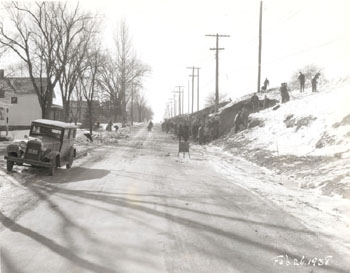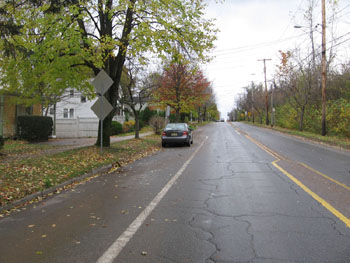
Louis L. McAllister
February 26, 1938

Sarah L. Graulty
October 29, 2006

East Avenue: North to Case Parkway UTM: 180643782E; 4926757N |
 Louis L. McAllister February 26, 1938 |
 Sarah L. Graulty October 29, 2006 |
This Louis McAllister image, dated February 26, 1938, shows a Burlington street widening project on East Avenue near Colchester Avenue that took place over the winter months in early 1938. Text printed on the back of the photograph explains that the street was widened to thirty feet and given a slope of 1-1.5 at the shoulders; the old power line was re-erected with new poles and fixtures and “placed in a position to allow for future development”.[1] The photograph was taken from the center of East Avenue looking south, and three houses are visible on the east side of the street. The farthest left is 94 East Avenue, whose porch roof and turned posts can just barely be seen at the edge of the image. One of the earliest residents, if not the earliest, of this house was Edward Tulley, an employee of Burlington Gas Light Company. An 1890 map of Burlington by C. M. Hopkins shows an E. Tulley as owner of a parcel of land with a small house on East Avenue, and the Burlington directory lists Edward Tulley on East Avenue as early as 1881-83. In 1938, the year McAllister took this photograph, Preston L. Catlin, a watchmaker, is listed at this residence.[2] The second house from the left, white with a large front porch and gable roof, is 102 East Avenue. This building was constructed circa 1907 for Edward Tulley, formerly of 94 East Ave, who moved into the house in 1908, from next door. The building first appears between 94 and 120 East Ave. in the 1908 Burlington directory, although it is numbered 96 East Ave. In 1909 and 1910, the Directory shows some confusion as to street numbers, listing both #96 and #102 to Tulley in different sections. By 1911, the address 96 East Ave is completely eliminated in favor of #102. In 1938, Norman R. Case, a retiree, is listed in the house. [3] Although Sanborn Maps did not extend far enough to include the next house, located at 120 East Avenue and slightly obscured by tress in the photograph, until 1926, an 1890 map by C. M. Hopkins shows a house in its location labeled Jas. Madigan. The Burlington directory verifies that in 1890, James Madigan, an employee at G. W. Benedict, lived at 120 East Avenue. In fact, the directory places Madigan in a house on East Ave. as far back as 1866-67, presumably the same Greek Revival structure that stands there today. In 1938, the directory lists retiree John H. Byrnes at this address. For a time, after the death of James Madigan, both Byrnes and Mrs. Catherine Madigan, James W. Madigan's widow, lived at the address[4], but by 1938, however, Byres is the lone resident.
[1] Louis L. McAllister, "Burlington Street Department Photographs" (Burlington: Bailey/ HoweLibrary, c. 1929-1941)
|
Between 1938 and 1942, according to Sanborn Maps[1], owners made a substantial addition to 120 East Ave., nearly doubling it in size. However, none of this can be seen from the contemporary point of view because immediately after Louis McAllister took his photograph in 1938, a house went up in between #102 and #120, fully obscuring the latter. This house appears for the first time on the 1942 Sanborn map and shows up in the Burlington directory in 1940. In the above photograph, it is the tall green house in the background with the low-pitched roof. Other than this new construction, this area of East Ave. looks much the same. The road is wider and #94 has been converted into apartments, but little else has been altered.
[1] Sanborn Fire Insurance Map, Burlington, VT, 1938, 1942. |
Historic Burlington Project Depression Era Streetscapes: Old North End | Burlington 1890 | Burlington 1877 | Burlington 1869 | Burlington 1853 | Burlington 1830 Produced by University of Vermont Historic Preservation Program graduate students in HP 206 Researching Historic Structures and Sites - Prof. Thomas Visser - in collaboration with UVM Landscape Change Program Historic images courtesy of University of Vermont Library Special Collections, Louis L. McAllister Photograph Collection |